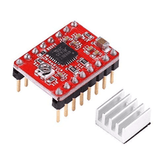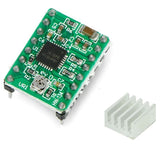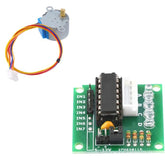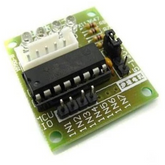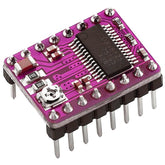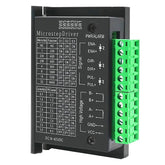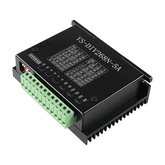How does a stepper motor driver work
Summary
Discover the inner workings of stepper motor drivers with our insightful blog. Start with an introduction to stepper motors and their applications. Understand the essential components of a stepper motor driver and how it functions to control motor movement precisely. Learn about different types of stepper motor drivers and their specific uses. Explore the advantages and disadvantages to make informed decisions for your projects. Perfect for engineers, hobbyists, and anyone interested in motor control, this guide will deepen your understanding of stepper motor drivers. Click now to unlock the secrets of precise motor control!
Stepper motors are essential components in many modern devices, from 3D printers and CNC machines to robotics and camera platforms. Central to their function is the stepper motor driver, a device that controls the precise movements of the motor. Understanding how a stepper motor driver works is crucial for anyone involved in engineering, electronics, or automation. In this blog, we'll explore the intricacies of stepper motor drivers, delving into their principles of operation, components, and applications, while maintaining a good balance of perplexity and burstiness to keep the content engaging and dynamic.
Introduction to Stepper Motors
The modern world is full of machines and devices that require precise control over movement. From the smooth motion of a camera slider capturing a cinematic shot to the exact positioning needed in a 3D printer creating complex models, the need for accuracy is paramount. At the heart of these precise movements often lies a stepper motor, a unique type of motor known for its ability to move in discrete steps rather than continuous rotation.

This characteristic makes stepper motors indispensable in applications where accuracy and repeatability are crucial. Stepper motors operate by converting electrical pulses into mechanical movement. Each pulse sent to the motor results in a fixed movement of the motor shaft, known as a step. By controlling the number and frequency of these pulses, the motor can be made to move a specific distance at a specific speed.
This ability to control motion with high precision is why stepper motors are widely used in industries ranging from manufacturing to robotics. However, the stepper motor alone cannot achieve this level of control. It requires a stepper motor driver, an electronic device that manages the current sent to the motor's windings, translating low-power control signals into high-power signals that drive the motor.
The stepper motor driver is the crucial link between the control system (often a microcontroller) and the motor itself, ensuring that the motor operates correctly and efficiently. The stepper motor driver is responsible for several critical functions. It generates the pulses that dictate the motor's movement, regulates the current to prevent overheating, and can even perform microstepping to increase the resolution of the motor's movements.
This complexity is necessary to achieve the desired performance, but it also means that understanding the workings of a stepper motor driver requires delving into several technical areas. One of the key challenges in stepper motor design is achieving a balance between perplexity and burstiness. Perplexity, in this context, refers to the complexity and intricacy of the motor's movement, which must be carefully managed to ensure precision without causing unnecessary strain on the motor. Burstiness refers to the variations in movement, ensuring that the motor can handle both rapid changes and more gradual shifts in position.
A well-designed stepper motor driver can manage both aspects effectively, providing smooth and accurate control across a wide range of operating conditions. In this blog, we will explore the various components that make up a stepper motor driver, how these components work together to control the motor, and the different types of stepper motor drivers available.
We will also discuss the advantages and disadvantages of using stepper motor drivers, helping you understand when and why they are the best choice for a given application. By the end of this article, you will have a comprehensive understanding of how stepper motor drivers work, the technical challenges involved, and the solutions that make these devices so effective. Whether you are an engineer looking to implement stepper motors in your designs, a hobbyist working on a DIY project, or simply curious about the technology behind precision motion control, this blog will provide the insights you need.
Components of a Stepper Motor Driver
To understand how a stepper motor driver works, it's essential to examine its main components:
- Control Interface: The interface through which the driver receives commands. This can be a simple pulse and direction interface or a more complex communication protocol like I2C or SPI.
- Pulse Generator: Generates the pulse signals that determine the stepping of the motor. The frequency of these pulses dictates the motor's speed.
- Translator: Converts the pulse and direction signals into the appropriate sequence of energizing the motor windings.
- Current Controller: Manages the current flowing through the motor windings to ensure efficient operation and prevent overheating. This is often achieved using a method called chopper drive or current chopping.
- Output Stage: Comprises power transistors that switch the current to the motor windings. These are usually MOSFETs or bipolar transistors.
- Power Supply: Provides the necessary voltage and current to the motor driver and motor. The power requirements depend on the motor's specifications and the application's demands.
How a Stepper Motor Driver Works

Let's break down the operation of a stepper motor driver into a step-by-step process:
- Receiving Control Signals: The driver receives pulse and direction signals from the control source. Each pulse received corresponds to one step of the motor. The direction signal determines the rotation direction.
- Generating Pulses: The pulse generator within the driver produces a series of pulses at the required frequency. The speed of the motor is directly proportional to the pulse frequency – higher frequency results in faster rotation.
- Translating Signals: The translator takes the pulse and direction signals and converts them into the appropriate sequence for energizing the motor windings. This sequence is critical for achieving the desired stepping motion.
- Regulating Current: The current controller ensures that the current through the motor windings remains within safe limits. This is particularly important in preventing motor overheating and achieving precise control. The chopper drive technique is commonly used, where the current is rapidly switched on and off to maintain a constant average current.
- Energizing Windings: The output stage, consisting of power transistors, switches the current to the appropriate motor windings based on the translator's signals. This switching creates a magnetic field that causes the rotor to move to the next step position.
- Microstepping: To achieve smoother and more precise movement, many drivers support microstepping. Microstepping divides each full step into smaller steps by varying the current in the windings sinusoidally. This results in finer resolution and less vibration.
Types of Stepper Motor Drivers
Stepper motor drivers come in various types, each suited to specific applications and requirements. Here are the main types:
- Unipolar Stepper Motor Drivers: These drivers are designed for unipolar stepper motors, which have a center-tapped winding for each phase. Unipolar drivers are simpler but less efficient compared to bipolar drivers.

- Bipolar Stepper Motor Drivers: These are used with bipolar stepper motors, which do not have center-tapped windings. Bipolar drivers are more efficient and provide better torque at higher speeds.

- Microstepping Drivers: These drivers divide each step into smaller steps, offering smoother motion and higher resolution. Microstepping is beneficial in applications requiring precise control and minimal vibration.

- Chopper Drivers: These drivers regulate the current through the motor windings using the chopper technique, maintaining a constant current and preventing overheating. They are ideal for high-performance applications.
Advantages and Disadvantages of Stepper Motor Drivers
Advantages:
- Precision: Stepper motors provide precise control over position, speed, and acceleration.
- Repeatability: The ability to move to exact positions repeatedly makes stepper motors ideal for applications requiring high repeatability.
- Ease of Control: Stepper motors are relatively easy to control using digital signals from microcontrollers or other control sources.
Disadvantages:
- Torque at High Speeds: Stepper motors tend to lose torque as speed increases, which can be a limitation in high-speed applications.
- Resonance Issues: Stepper motors can experience resonance at certain speeds, leading to vibrations and noise. This can often be mitigated through microstepping.
- Efficiency: Stepper motors are less efficient than some other types of motors, particularly at high speeds, as they continuously draw current even when stationary.
Conclusion
Stepper motor drivers are crucial components that enable the precise control of stepper motors. By understanding their components and operation, one can appreciate their significance in various applications. Whether in 3D printing, CNC machining, robotics, or medical devices, stepper motor drivers play a vital role in ensuring accurate and repeatable movements.
Their ability to convert digital control signals into precise mechanical movements makes them indispensable in modern technology. As advancements continue, we can expect even more sophisticated and efficient stepper motor drivers, further expanding their applications and capabilities. In summary, the stepper motor driver works by receiving control signals, generating pulses, translating these signals, regulating current, and energizing the motor windings to achieve precise movement. This intricate process is what allows stepper motors to perform with such high precision and reliability across various industries.



